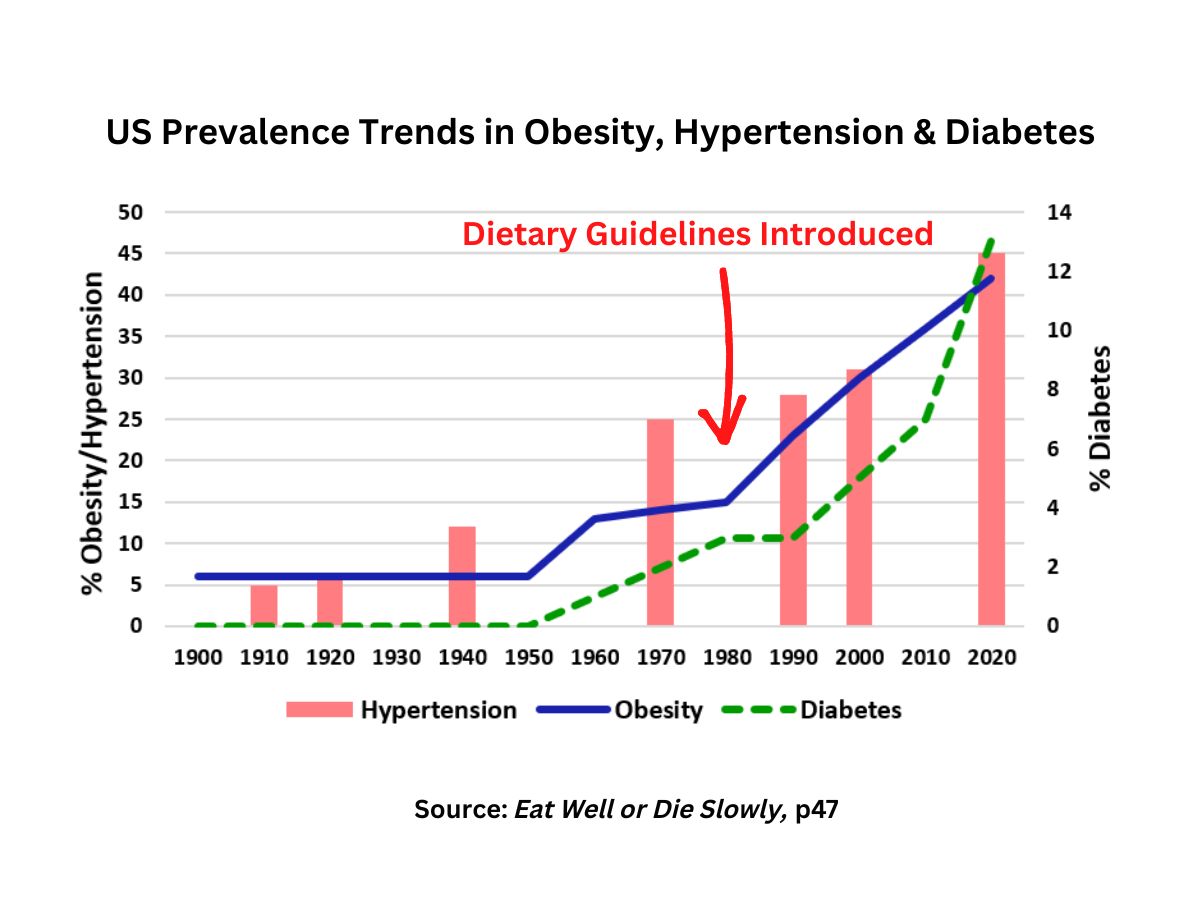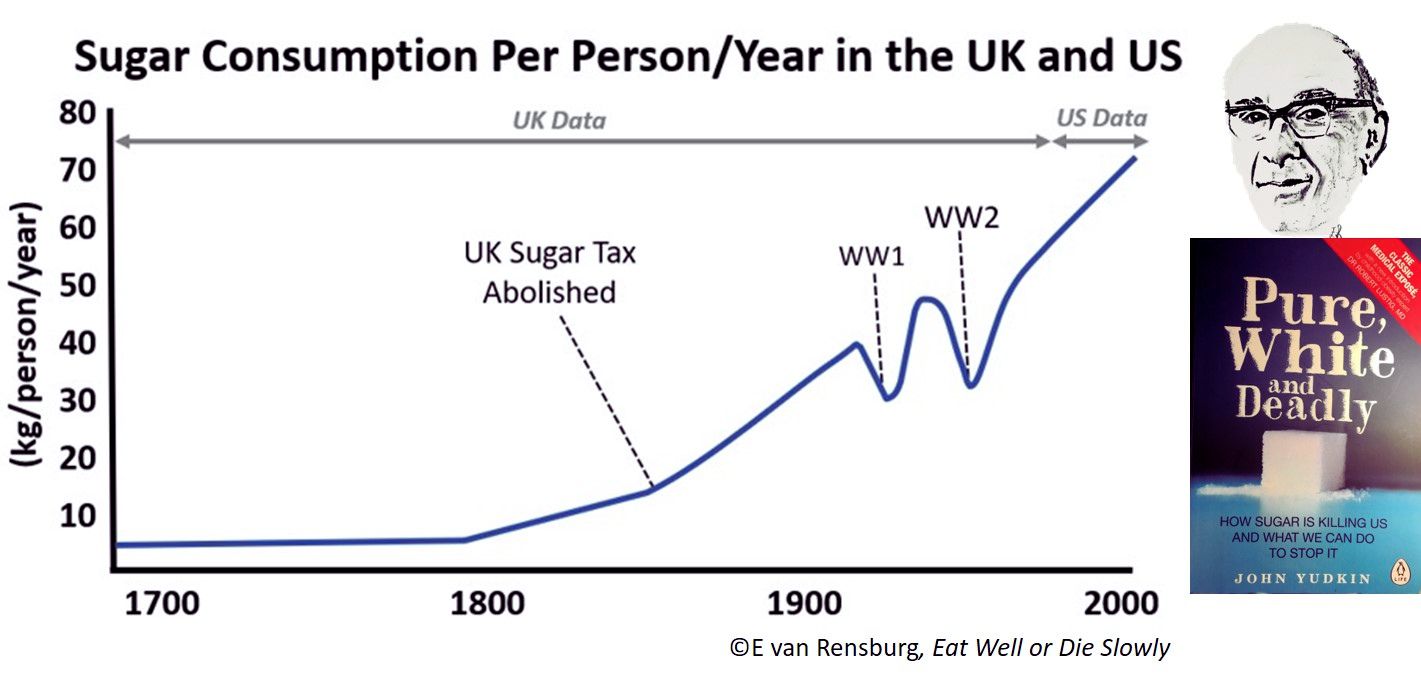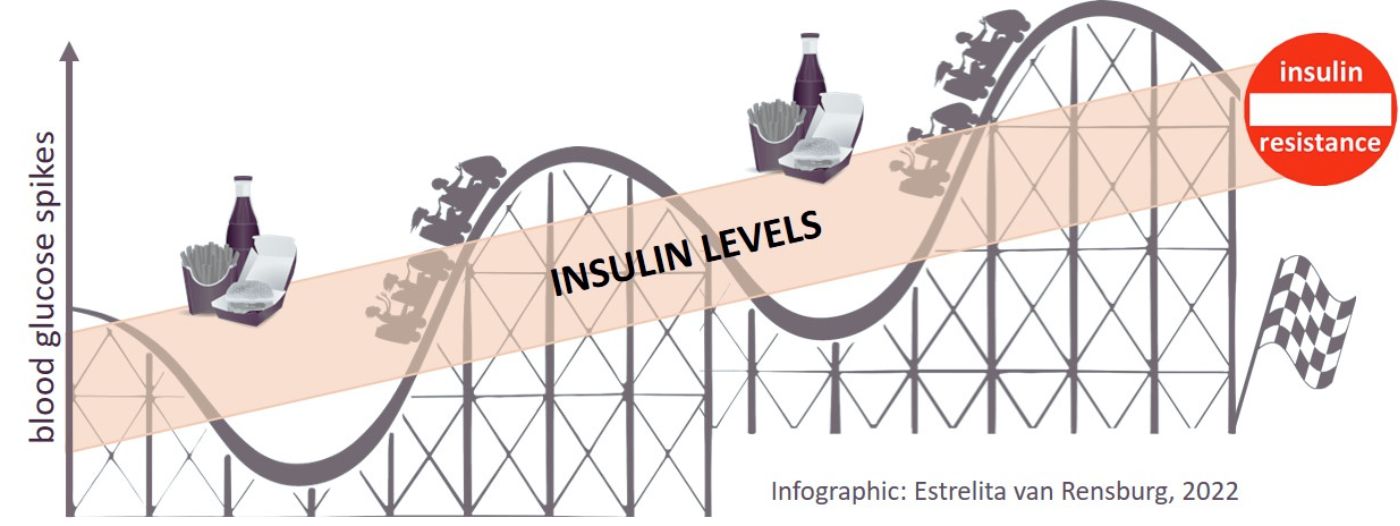Chronic Illness and Diet

Written by Dr Estrelita van Rensburg
Chronic illness and diet - Introduction
Central to human health today is the number of people who suffer from weight issues, obesity, high blood pressure, diabetes, cancer, inflammatory bowel disease, Alzheimer's disease and many other chronic diseases. Did you know that these are all examples of diet-related chronic diseases? Making healthy food choices is the most important step in chronic disease prevention.
We used to think that the risk of chronic diseases is something that happens in old age, but this is no longer the case. Young people in their twenties and thirties struggle with weight issues and some develop type 2 diabetes.
More than that - many children and teenagers are nowadays affected by weight issues and type 2 diabetes. Why is this the case - it has not always been like this?
Just take a look at mid-twentieth century photographs of people, because you will be hard pressed to spot an overweight or obese person!
Scientists studying traditional societies in many different parts of the world found them to be spectacularly healthy, even in advanced age. Yet, this healthy condition changed within a generation when they became exposed to a Western lifestyle and diet, which impacted their food choices.
As soon as they changed to a typical Western diet of processed food, their chronic disease risk increased.
In order to understand why this is happening, we need to answer the following question - what, if anything, changed over the last 100 years that impacted our collective lifestyle?
Politicians approve food guidelines
In 1983, the UK Government introduced dietary guidelines, also known as the Eatwell Guide which advise the public what they should eat. This was based on the ‘My Plate' Dietary Guidelines for Americans, originally compiled by the pro-vegetarian Senate Select Committee of Senator George McGovern in the late 1970s.1
In essence, the recommendations of this dietary intervention advice were to reduce animal fat and increase the carbohydrate content of our diet. The US Senate ratified this guidance in 1980.
This dietary advice did have an effect. It had a significant impact on the food choices people made as shown by data collected by the CDC from 1970 to 2000. Overall carbohydrate intake increased - it is the macronutrient consumed in highest quantities, while fat consumption decreased.
Since saturated fat was vilified, low fat dairy products were recommended and are now most commonly used. This has unfortunately led to an inadequate intake of healthy fats (see our blog - Is fat good or bad). There has also been a slight downward trend in protein consumption.2
The rise in carbohydrate consumption is driven by several factors - increased consumption of fruits and vegetables, added sugars found in all processed food items and sugar sweetened beverages, including fruit juices.
Chronic diseases trends increase after government dietary recommendations
As the population's food choices changed over time (to a high carb diet with low fat dairy products), the epidemiological data of chronic diseases also changed.
The figure below shows increasing trends in the US for obesity, hypertension (high blood pressure) and diabetes since 1900. Moreover, there was a noticeable increase of all three conditions after the second World War.
However, the most dramatic increase occurred since 1980 when the dietary recommendations were first introduced.3
 US Prevalence Trends in obesity, high blood pressure and diabetes
US Prevalence Trends in obesity, high blood pressure and diabetes
Other chronic diseases linked to diet such as cancer and Alzheimer's dementia have also increased. On a yearly basis, roughly 10 million people die from cancer, almost 20 million die from heart disease, 50 million globally suffer from Alzheimer’s disease and 500 million people have diabetes.4
Today, seven out of the ten leading causes of deaths globally are due to non-communicable chronic diseases.
A bias against animal protein and fat
The UK diet and health researcher, Dr Zoe Harcombe, calls the Eatwell Guide staggeringly unbalanced and nutritionally deficient5. Content analysis of the diet shows that it is based on refined grain-based foods (high carbohydrate content), man-made vegetable oils and seed oils (known to be highly inflammatory) and many products such as highly processed food containing added sugars and sweeteners (high carbohydrate content).
Low fat dairy products are also recommended. This recommendation follows on the ‘cholesterol and saturated fat heart disease' theory, first championed by Professor Ancel Keys from the University of Minnesota in the early 1950s.
Professor Keys' theory later became discredited when it emerged that, on several occasions throughout his research career, he used biased data, sloppy science and incorrect assumptions to ‘prove' his theory. The data produced did not withstand rigorous scientific scrutiny.6
Ancel Keys was a powerful individual who actively targeted and undermined scientists who disagreed with him. He ultimately won the battle, since he had the support from powerful bodies in American healthcare, the US Senate as well as the food, drinks and pharmaceutical industries.
These industries greatly benefit financially by aligning the products they produce to the recommendations of the official dietary guidance. This guidance has not changed much over the years, in spite of the continued rise in chronic diseases.6,7
Chronic disease causes - is it sugar?
In the 1950s, Professor John Yudkin from the Queen Elizabeth College in London put sugar forward as an alternative dietary explanation for cardiovascular disease. He documented the dramatic increase in sugar consumption since the 1800s in the UK and US in his book Pure, White and Deadly (published in 1972).
Through a series of laboratory experiments on animals and humans, he observed how sugar was processed in the liver, and turned into fat before entering the bloodstream. As a result of this, he and others pointed out how sugar, not fat or cholesterol, was the prime suspect in the rising epidemics of obesity, diabetes, high blood pressure and cardiovascular disease.8,9
Sugar consumption started in the nineteenth century with the development of sugar plantations in the Caribbean. When the UK abolished sugar tax just after the mid nineteenth century, consumption rose dramatically.
This has continued ever since, apart from two dips during the two World Wars in the twentieth century. By the year 2000 sugar consumption in the US was estimated at 70 kg (155 pounds) per person per year!
 Sugar consumption per person per year: UK and US
Sugar consumption per person per year: UK and US
Illness follows dietary changes
As mentioned, the scientifically unproven ‘fat cholesterol heart health' concept still prevails today. It is supported by the vociferous and intimidating voices of the plant-based/climate-angle dietary movement, as well as many in medical academia and mainstream healthcare settings.10
However, it is scientifically proven that a high carbohydrate diet - all types of sugar and starch - present in all the highly processed food and drinks items lining the aisles of our supermarkets and corner shops, drives a metabolic condition where our cells and tissues are no longer responding to the hormone insulin (see below).
This condition is the forerunner of dementia, cardiovascular disease, diabetes, cancer and obesity, and is infrequently diagnosed. What makes it so scary is that it is the most common health disorder in the world, affecting almost 90 per cent of adults!
Most GPs don't know how to diagnose the condition since the topic is not covered in the curricula of medical schools.
How decreased insulin sensitivity develops
Insulin is a hormone produced in our bodies to regulate our blood glucose (aka blood sugar) levels. When we eat food that increases blood glucose levels, such as all types of sugar and starch, our pancreas releases insulin which transports glucose into the cells of our organs (brain, muscles, heart, kidneys etc), where it produces energy for all the cellular processes.
When we eat or drink of lot of sugar and starch over time, our body is exposed to high insulin levels - regularly and continuously. This is a very unhealthy situation. Over time, the cells in our tissues stop responding to insulin – they resist the effects of insulin.
When this happens, glucose can no longer be transported efficiently into our cells. Without glucose, energy cannot be produced. As a result, our cells and tissues are now ‘starving for energy', cannot function normally and many cells die. This condition is called insulin resistance.
 Insulin resistance develops over time with progressively higher insulin levels
Insulin resistance develops over time with progressively higher insulin levels
Starch such as bread, pasta, rice, cereals, biscuits, cake, fruit and all types of sugar (don't forget fruit juices and fizzy drinks), are the food types which most effectively drive the development of insulin non-responsiveness. It inevitably takes us on a roller-coaster ride of spiking blood glucose values driving insulin levels higher and higher.
It is a serious condition. If left untreated, it can give rise to one or more of the following conditions - high blood pressure or other cardiovascular complications, type 2 diabetes, breast or prostate cancer, Alzheimer's dementia or any number of other associated chronic diseases.11
How to know if you have abnormal insulin levels
To get a sense of your risk level, answer these questions:
- Do you carry more belly fat than you'd like?
- Is your waist: height ratio greater than 0.5?
- Do you suffer from high blood pressure?
- Do you have type 2 diabetes?
- Do you suffer from infertility (polycystic ovary syndrome for women or erectile dysfunction for men)?
- Do you have high levels of blood triglycerides?
Although the list is not comprehensive, if you replied ‘yes' to one or more questions, you likely have insulin resistance.
Can we increase our insulin sensitivity?
The disease process of insulin resistance cannot be treated with drugs. Dr Robert Lustig, a paediatric endocrinologist, summarises the current state of affairs: ‘Modern Medicine works downstream of the problem by treating the symptoms, rather than working upstream to treat the cause.'12
Changing our diet is the only way to address the condition. We are not talking about the traditional calorie-restricted diet - it is not going to work because it is based on the concept of eating less of the same types of food that caused the problem in the first place. A little bit less of a bad thing doesn't make it a good thing.
The root cause of the problem is high insulin levels and the only way to reduce that is to drastically cut sugar and starch (carbohydrate) intake.
We need to go back to the type of diet our ancestors ate before the advent of industrialised food production. Eating real food is key - the food our great-great grandmothers prepared, rich in animal protein and fat. In a nutshell:
- avoid all processed foods: pre-packed, pre-boxed and fast food
- eliminate all refined carbohydrates (anything made from white or whole meal flour and rice)
- exclude all forms of sugar, fizzy drinks and fruit juices
- stick to leafy green vegetables and berries
- eat ample amounts of natural fats and protein (meat, butter, fish, eggs, cheese, coconut oil, nuts, avocado)
When is a good time to make changes?
NOW is the time. Whether you are young or old. It is never too late, but also, it is never too early! Through correct nutrition we can improve our metabolic health risks, prevent chronic diseases or even put type 2 diabetes in remission.
Sugar addiction is one of the most serious addictions of our time, and starts very early in life. For some people it is the sweet stuff (chocolates and desserts) that they cannot resist, while for others it's bread and flour products.
The first step in dealing with addiction is to know that you have a problem. For instance, some behaviours to look out for are:
- can't cut back when eating something
- have cravings or fantasies about food
- can't stop yourself from eating more and more
In conclusion, help is available if you need guidance on healthy food choices or how to implement healthy dietary patterns. Make it part of your own healthy lifestyle.
References
- The Eatwell Guide; US Department of Health and Human Services and Department of Agriculture. Nutrition and Your Health: Dietary Guidelines for Americans. Washington, DC: US Government Printing Office; 1980.
- Trends in intake of energy and macronutrients – United States, 1971-2000. MMWR Morb Mortal Wkly Rep. 2004;53(4):80-82.
- Van Rensburg E and Warrack I: Eat Well or Die Slowly: Your Guide to Metabolic Health, UK: Wellness EQ Publishers, 2020. https://bit.ly/EatWellorDieSlowly
- Bikman B. Why We Get Sick. Dallas: Ben Bella Books, 2020.
- Harcombe, Z: Newsletter: The Eatwell Guide is nutritionally deficient, 2018.
- Teicholz N. The Big Fat Surprise. New York, NY: Simon and Schuster; 2014.
- Noakes T. 2020. CrossFit: Ancel Keys' Cholesterol Con, Part 1 & Part 2.
- Yudkin J. Pure, White and Deadly, Revised edition. England: Penguin Life; 1986
- Cleave TL. The Saccharine Disease. Bristol, UK: John Wright & Sons Ltd, Stonebridge Press; 1974
- Buxton, J. The Great Plant-Based Con. London: Piatkus, Little Brown Book Group; 2022.
- Crofts CAP, Zinn C, Wheldon M, Schofield G. Hyperinsulinemia: A unifying theory of chronic disease?2015;1(4):34-43. doi:10.15562/diabesity.2015.19.
- Lustig, R: Metabolical: The Truth About Processed Food and How it Poisons People and the Planet. London, Yellow Kite, 2021.

